In the Western world the swastika is synonymous with fascism, but it goes back thousands of years and has been used as a symbol of good fortune in almost every culture in the world. In the ancient Indian language of Sanskrit, swastika means “well-being”. The symbol has been used by Hindus, Buddhists and Jains for millennia and is commonly assumed to be an Indian sign.
It was also used in Ancient Greece and Rome, and can be found in the remains of the ancient city of Troy, which existed 4,000 years ago. The ancient Druids and the Celts also used the symbol, reflected in many artifacts that have been discovered. It was used by Nordic tribes, and even early Christians used the Swastika as one of their symbols, including the Teutonic Knights , a German medieval military order, which became a purely religious Catholic Order.
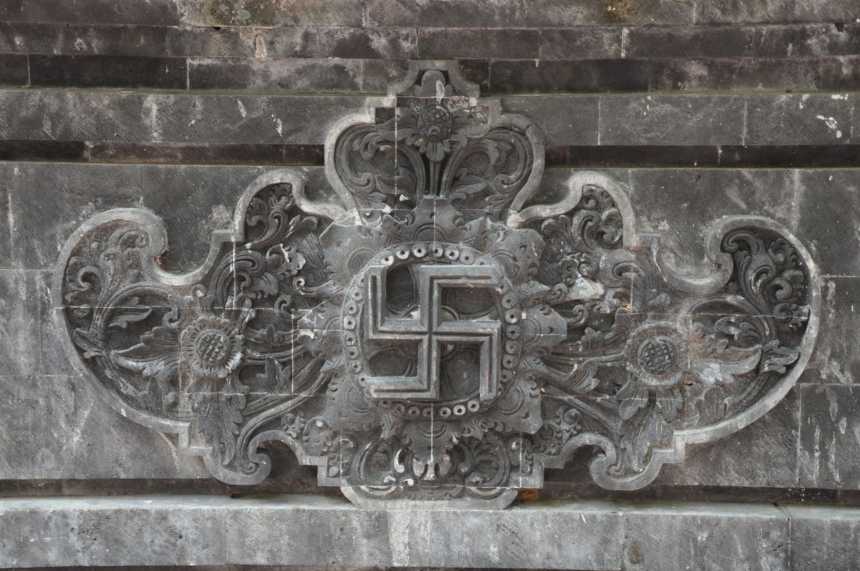
The Nazi use of the swastika stems from the work of 19th Century German scholars translating old Indian texts, who noticed similarities between their own language and Sanskrit. They concluded that Indians and Germans must have had a shared ancestry and imagined a race of white god-like warriors they called Aryans.
Three Important Contributors to the Adoption of the Swastika
Three German scholars — Jorg Lanz Von Liebenfels, Guido Von List and Rudolf Von Sebottendorff — played a major role in making the swastika one of the most tragically infamous historical symbols.
Guido Von List
Born in 1848 in Vienna, Guido Von List may have been one of the very first adopters of the swastika as an ideological symbol. He was a proponent of a pagan religious movement known as Wotanism that revived the ancient Germanic lore and combined it with Ariosophical teachings. Ariosophy was allegedly the study of Aryan wisdom. In 1877 he started a carrier as a journalist as a proponent of ‘völkish’ themes. He quickly began to embrace anti-semitic views; he founded a literary society in 1893 and got involved in the Pan-German nationalist movement which sought the integration of Austria into the German Empire. A society of his name was founded in 1908, of which Liebenfels was a member.

List even presided over a sort of a cult called the High Armanen Order. He believed that the establishment of the Pan-German Empire, based on Wotanism, would be completed through a Central Powers’ victory but he died in 1919 while in Berlin as Germany was defeated. However in 1875, List had visited the site of the Battle of Carnuntum where the ancient tribes defeated the Roman Legions. There, he buried eight bottles in the shape of a swastika under the Pagan Gate of the commemorative monument. We can then guess that the ‘Aryanization’ of the swastika was already taking place at that time.
Jorg Lanz Von Liebenfels
The Founder of Ario-Christianity, an esoteric philosophy, Lanz von Liebenfels, was born in 1874 in Austria. A Cistercian monk, Liebenfels was the sole author and editor of a publication called ‘Ostara’, an anti-semitic and völkish magazine which counted Hitler, Dietrich Eckart and Kitchener as readers.
The concept of ‘völkish’ was seen in everything related to German nationalism in the latter part of the nineteenth century. In 1907, Liebenfels created Ordo Novi Templi — the Order of the New Templars. He even acquired a dilapidated castle, the Werfenstein castle to host the Order. Their flag displayed a swastika emblazoned with French lys flowers.
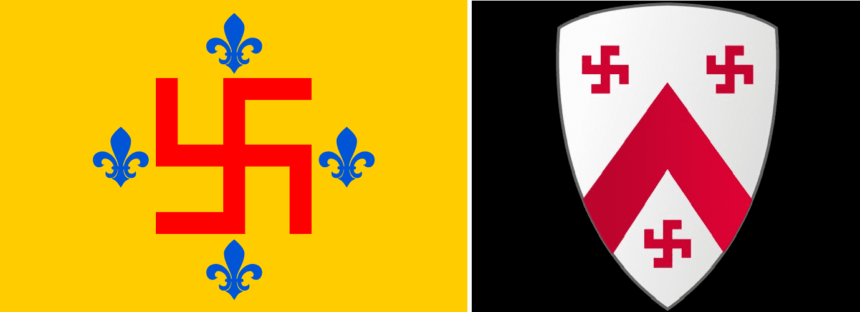
It is interesting to note that the swastika is already oriented in the same direction used later in the Nazi propaganda. In other representations in ancient English culture, the swastika is seen clockwise as well as counter-clockwise under the names of ‘fylfot’ and ‘gammadion’.
Liebenfels claimed to have been ‘enlightened’ when he found a Templar Knight’s tombstone. He was second only to von List in his role as a proponent of Aryan racial theories, eugenics and esotericism.
Liebenfels was a follower of Guido von List and in 1905 he endorsed the Guido von List Society. After Hitler’s rise to prominence in the 1920s, Liebenfels tried to be recognized as a precursor of the nationalist movement. He declared in 1927, ‘one must remember that the swastika movement is basically an offspring of Ostara’. Hitler banned Liebenfels from publishing Ostara.
Among Liebenfels’ ‘enlightened’ publications can be found ‘The World War as a Race fight between the Dark and the Blondes’.
Rudolph Freiherr von Sebottendorff
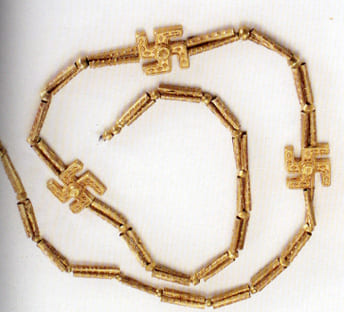
The ‘Baron von Sebottendorff’ was actually born Rudolf Glauer in 1875.
He became a Turkish citizen in 1911 and was adopted by the original Baron von Sebottendorff from whom he gained his title. It is interesting to follow the trail von Sebottendorff took from his participation in the Turkish Masonic Lodges to the foundation of the Thule Society, a forerunner of Nazism.
First, he frequented a number of Lodges including the one that Garibaldi had belonged to, called the Rite of Memphis-Misraïm.
The Turkish lodges were linked to the predecessor of Ataturk’s Young Turks, the Committee of Union and Progress. With the help of prominent Masons, Sebottendorff was initiated to the esoteric traditions over the years.
He also studied with the Sufi Bektashi Order strengthening his Masonic knowledge.
The Bektashi was an important political and ideological component of the Middle Eastern world.
Sebottendorff creates the Thule Society
By 1919, Sebottendorff had created the Thule Society or Thule Gesellschaft in Munich. The Thule Society was going to become instrumental in the birth of Nazism.
Incorporated in the poster seen above, the swastika was now definitely a visual element central to the German nationalist movement.
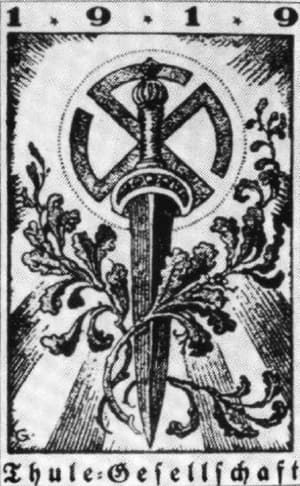
The Swastika becomes widely used by the nationalists
After World War One, the newly established Nazi Party formally adopted the Hakenkreuz (meaning “hooked-cross”) in 1920. The emblem was a black “Hooked Cross” rotated 45 degrees on a white circle on a red background. This insignia was used on the party’s flag, badge, and armband.
Here it is seen painted on warplanes:

During the 1920 Kapp Putsch, the Freikorps displayed the swastika as a rallying symbol.
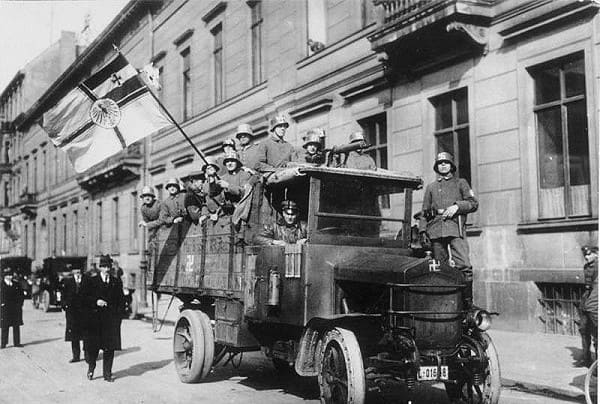
The Marine Brigade Ehrhardt which we see in action above was instrumental in the 1920 failed coup and displayed swastikas on their equipment and the so-called ‘Viking Sail’.
Later an SS division displayed its own version of the Viking Sail.

The Swastika is adopted for the worst reasons
For historical reasons still being studied, the German political nationalist movement first ‘adopted’ the swastika as their visual symbol, like a counterpart to the Communists’ symbol, the sickle, and the hammer.
Still today, the swastika retains its evil meaning and is forbidden by various countries, while, in a tragically ironical twist of fate, it was originally supposed to mean good luck and fortune.


